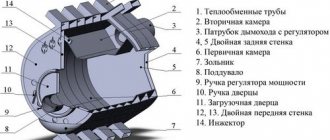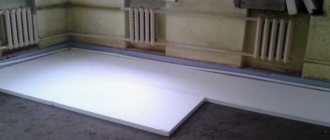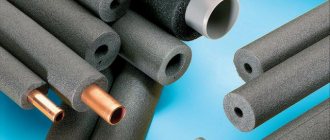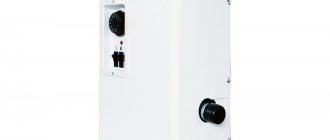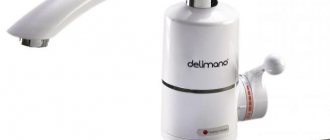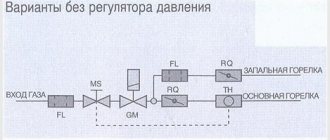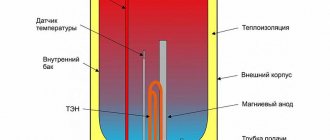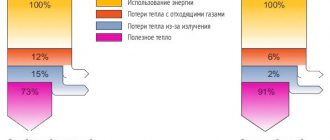Installation goals and benefits
Installing thermostats on radiators allows you to set the desired temperature in the rooms. The device changes the volume of coolant supply, which accordingly reduces the air temperature.
The thermostat is an excellent alternative to the ball valves that are familiar to many. Their use is not always convenient or advisable. The tap must be constantly opened and closed, which leads not only to temperature fluctuations in the room, but also to the failure of the part itself.
By installing a thermostat, these problems can be avoided. In this case, there is no need to periodically open and close the tap.
Pros of a thermostat:
- processes for adjusting the coolant supply are performed automatically;
- there is the possibility of zonal change of parameters;
- reducing the volume of coolant entering the battery allows you to reduce heating costs;
- no maintenance required.
In boiler rooms, a thermostat is used to protect against overheating and excessive loads. The device will prevent accidents by controlling the increase in temperature and water pressure.
Thermostat settings (W1209)
To enter the setup mode, you need to hold the “SET” button for 5 seconds, then use the “+” or “—” button to select the menu to be changed (P0 . . . P6).
To enter and exit the menu, press the SET button once.
PO - Thermostat operating mode
In this section of the menu, the operating mode is set to C - cooling or H - heating; when selecting mode C, the relay will operate when the temperature drops to the set value.
If mode H is selected, the relay will operate if the temperature relay is activated when the temperature rises to the set value.
P1 - Hysteresis setting
In this menu item, you can configure the hysteresis (the difference between the on and off temperatures), the value is from 0.1 °C to 15.0 °C, the default is 2 °C, the change step is 0.1 °C.
For example, if the value is set to 2 °C, and the operating temperature is 20 °C and mode H, then at a temperature of 22 °C, the thermostat will turn off the heating, and at a temperature of 18 °C it will turn on the heating.
P2 - Upper temperature limit
Setting the upper temperature limit value from -45 °C to 110 °C, default 110 °C, change step 1 °C.
P3 - Lower temperature limit
Setting the lower temperature limit value from -50 °C to 105 °C, default 110 °C, change step 1 °C.
P4 - Temperature adjustment
In this section you can calibrate the thermometer readings, provided that you have a reference thermometer, value from -7 to 7, default 0, change step 1.
P5 - Relay activation delay
Here, the switch-on delay is set to 0 ... 10 minutes.
P6 - Upper limit of shutdown temperature
Menu for setting emergency temperature overshoot from 0 °C to +110 °C, OFF by default.
Types of thermostats
Based on their operating principle, thermostats are divided into mechanical, electronic and semi-electronic. Each type differs in design, operating principle, and has certain advantages and disadvantages.
Mechanical
Manually configured device. The device consists of a thermal valve and a highly sensitive head.
The mechanism operates stably and efficiently without external energy according to the following principle:
- Under the influence of temperature, the volume of coolant in the system changes.
- The bellows senses the changes and moves the control valve.
- The sensing element moves the rod, which regulates and controls the flow of coolant into the radiator.
The main advantages of mechanical thermostats:
- low cost;
- ease of installation.
But mechanical devices have more disadvantages:
- less efficiency;
- the need for constant adjustment;
- rapid failure of the protective cap.
Electronic
Electronic thermostat
A microprocessor is installed inside this device, which is responsible for heating the radiator. The device is equipped with a sensor that measures the heating of the coolant or air in the room. The received data is used for configuration. This type of thermostat can be adjusted by degrees.
To adjust the electronic device, use a keypad. The indicators are reflected on the display. The electronic device has a mechanical part in its design that is similar to the device described above. The bellows in the device are cylindrical, the walls are made in the form of corrugations.
Expert opinion
Grebnev Vadim Savelievich
Heating system installer
Inside there is a substance that reacts to the surrounding temperature. When heated, it expands and increases the pressure inside. The position of the rod changes, thus regulating the volume of coolant. When the temperature decreases, the reverse process occurs. The service life of the electronic thermostat is at least 10 years.
Manufacturers offer users 2 types of electronic devices:
- closed - with auto-tuning;
- open - all settings must be entered independently.
Semi-electronic
The principle of their operation is similar to mechanical, but there are some differences. The bellows head is oriented to the room temperature. The sensor of the devices is remote. It is connected to the working part by a capillary tube.
We customize the W1209 digital thermostat to suit your needs
After correctly connecting the W1209 thermostat (you can see it in this article), we move on to setting the temperature and other settings.
Depending on what we need to heat or cool (at a given temperature the relay will either close or open the contacts), we set one of two modes: cooling or heating. To do this, press and hold the “SET” button for more than two seconds, the display will show “P0”, this means that we have entered the program menu. The “+” and “-” buttons navigate through the program menu, but in our case we are at the desired value “P0”, so press the “SET” button again and select the desired mode: “C” is cooling, and “H” heat.
The next setting in menu “P1” is hysteresis, this is the temperature difference at which the thermostat turns on or off (factory setting 2°C). For example, the thermostat is set to turn off at +40°C; when this temperature is reached, the relay will open. And it will turn on only when the temperature drops to the set hysteresis, that is, at +38°C.
The next two menu items:
- “P2” is the upper limit for setting the maintained temperature (factory setting +110°C).
- “P3” is the lower limit for setting the maintained temperature (factory setting -55°C). When these temperatures are reached, the W1209 thermostat will be turned off.
Next in the menu is temperature correction “P4”, you can calibrate the temperature readings to one tenth of a degree (default 0°C).
Menu item “P5” is responsible for the relay activation time delay, which can be set to 10 minutes. (default setting 0 min).
The last item “P6” allows you to control overheating protection. OFF – protection is disabled, ON – protection is enabled.
Setting the temperature: press the “SET” button, the indicator will start blinking, use the “+” and “-” buttons to set the desired temperature.
To reset to factory settings you need to:
- turn off power
- press and hold the “+” and “-” buttons
- supply power to the thermostat
The LED display will show “888” and then display the current temperature.
Effective heating control is a vital part of running your boiler and home heating system efficiently. Proper use of controls will reduce the energy consumption of the unit, while creating a comfortable temperature in every room of the house, avoiding overheating of the premises. A thermostat (or programmer) controls the operation of the boiler depending on the room temperature.
Up to 20% of the volume of energy consumed can be saved by using this type of automation. And energy prices are quite high and every normal person wants to reduce their expenses.
We consider a situation where the boiler is calculated correctly, the necessary insulation of the premises has been completed, and the heating system is functioning normally.
Device selection criteria
When selecting a thermostat, they are guided by the type of heating system installed in the house and the following characteristics:
- Material . The body is made of bronze, brass, nickel-plated or stainless steel. The optimal choice is stainless steel. The material is chemically neutral, does not rust and does not react with other metals. But the cost of such models is quite high. Bronze and brass appliances have the same service life. In this case, the quality of the alloy is important. It is carefully monitored by well-known manufacturers, so preference should be given to them.
- Method of execution . Radiators in houses are installed in different ways; accordingly, the valves are made straight (through) and angular (vertical and horizontal). There are models whose pipes and heads are located in 3 perpendicular planes.
- Compliance with the heating system . For single-pipe systems, large hydraulic resistance values on the control valves are not suitable. Therefore, models for them need to be selected with a wider cross-section. In the accepted classification, it is marked with the letter index G (for example, RTR - G). They are also suitable for two-pipe natural circulation systems. For two pipes with forced circulation, where the pressure reaches significant values, other models are used: marked N or D.
- Sensor type . Gas and liquid thermostats come with a remote or built-in sensor. It is better to use remote ones when the battery is behind thick curtains, the thermostat is installed vertically, the radiator depth is more than 16 cm or it is located in a niche. Devices with a built-in sensor require air circulation around them, so they are installed horizontally.
Do not try to install thermostats on all batteries. To ensure normal regulation in each room, it is worth equipping no more than 50% of heating devices with devices: 1 out of 2, 2 out of 3, and so on.
Difference between gas and liquid appliances
An important criterion for choosing a device is the type of internal filler.
When purchasing, you should pay attention to the following points:
. The gas reacts smoothly to temperature changes, and this does not cause excessive or sudden stress on the equipment.
Gas models have a long service life of about 20 years.- Liquid thermostats operate quickly . This affects the wear of working parts, but allows you to quickly respond to a drop or rise in temperature.
- In liquid thermostats, the sensor can be remote or built-in . If it is built-in, the device is placed in a horizontal position. It is advisable to install remote sensors when the device is covered with curtains, the thermostat is located vertically, the radiator is installed in a niche or at a distance of less than 10 cm from the window sill.
How to connect and set up a floor heating thermostat
A comfortable temperature in homes these days is created by a “warm floor” system with a water or electric heating design. Its operation is controlled by a control device in combination with one or more sensors.
Programmable thermostat for heated floors
When heating mats are turned on or off, sensors transmit information to the thermostat for the heated floor. Thanks to the operation of the device, a preset temperature that is comfortable for others is maintained in the room.
Operating principle of the thermostat
Thermostats are special devices for adjusting the thermal conditions in a room depending on weather conditions. They are reliable, easy to operate, and, as a rule, serve for many years without breakdowns or failures in configuration modes.
The devices are designed to be used by people of any level of knowledge. That is, they can be controlled, including by teenagers and the elderly.
Thermostats are designed to set the minimum temperature for each room in the house individually. This is especially true for models with programming of the device’s operating mode throughout the day.
The working tool is the remote thermostat of the “warm floor” system (WTP). Its purpose: when the temperature set on the device is reached, open or, on the contrary, close the electrical circuit.
As a result of this action, the system stops or resumes heating. Thermostats are divided into the following types:
Mechanical structures
The temperature sensor is a bimetallic plate that closes the contacts of the heating mats. When the temperature in the room rises, the plate bends and opens the electrical circuit, resulting in the supply of electrical energy being stopped.
Once cooled and straightened, the plate closes its contacts again, resuming the cycle.
The temperature in the room is changed by rotating a special wheel. Despite the primitive design, minimal functionality, and the impossibility of installing a remote control, the mechanical thermostat continues to be used due to its features:
- ease of settings during operation;
- low cost;
- reliability of the design when operating at high and low temperatures;
- independence from energy interference;
- The device automatically turns on with electricity after it is turned off.
Electronic thermostats
Thermistors are used as temperature sensors in relay (electronic) temperature controllers. Thermistors, when the environment heats up, change the resistance to the electric current, which is recorded by the control chip that transmits the relay signal.
The relay winding opens the contacts, breaking the circuit, and the power circuit is de-energized.
The ambient temperature drops by 1 degree, no more, the circuit closes, resuming heating of the “warm floor” system.
There are models of electronic thermostats to which other isolated sections of heated floors, equipped with their own sensors, can be connected.
Electronic or relay thermal structures are more advanced in comparison with mechanical analogues and have the following advantages:
- sensor, remote element of the thermostat, can be installed in any convenient place in the room;
- the set temperature and the recorded current data are displayed on the display;
- the ability to control the temperature in several zones of the “warm floor”;
- the temperature sensor records the temperature and displays it on the display with an accuracy of a few fractions of a degree;
- It is possible to equip it with a remote control unit.
The electronic circuits of thermostats largely depend on the voltage state in the electrical network.
When voltage drops and short-term power outages occur, disruptions in the stable operation and settings of the electronic device microcircuit are observed. When calculating the cost, electrical structures are much higher in price than their mechanical counterparts.
Programmable electronic devices
Programmable thermostats are designs that store the data of the set temperature regime. Such devices are installed in systems with built-in electric heating elements.
They provide an automatic process for setting and adjusting the temperature in equipment designed for cooling or heating systems.
The need for thermostats is to provide devices equipped with elements for changing temperature indicators, turning them on/off when certain temperature parameters are reached.
With the help of thermostatic structures, the controlled environment will have the desired temperature.
The operating principle of programmable devices is the same, regardless of the device they are built into:
- a temperature sensor, built-in or remote, must transmit accurate information to the thermostat, which regulates the temperature by increasing or decreasing the power of the heating device;
- the efficiency and quality of operation of “warm floors” with any heating element depends on the temperature sensor;
- temperature sensors are placed in the room so that they are removed from points that affect temperature changes, since distortion of the sensor readings will introduce an error into the operation of the thermostat;
- high-quality operation of the sensors allows the temperature controller to maintain comfortable environmental conditions in the room;
- thanks to the accuracy of transmitting readings to the control device, the floor covering will not be overheated and damaged;
- advanced functions of the programmable thermostat microcircuit provide individual temperature settings for a separate room depending on the time of day or other requirements;
- The operation of the energy system at home is stabilized, which is necessary for calculating the economical consumption of electricity in Moscow.
There are the following types of temperature sensors used in the “warm floor” system. any of them can be built into the thermostat housing or installed at some distance:
- the sensor for determining the ambient air temperature must be provided by the air circulation of the given room;
- infrared elements designed to remotely measure the temperature of a heated floor covering can be built into a programmable thermostat or separated into a separate unit. For such a combination, the only requirement must be met: the absence of obstacles between the sensor and the controlled surface. the distance between them must be equal to or exceed 30 cm;
- contact elements for measuring the temperature of the floor surface are a structure consisting of a wire connected at one end to a thermostat. The other end with a thickening is placed in a corrugated tube located under the floor surface;
- combined sensors for measuring floor surface temperature.
Several sensors can be connected to a contact thermostat, which allows servicing several zones in one house or apartment into several rooms for different purposes.
Rules for setting the thermostat
The primary setting of thermostats of any type is to check the overall performance of the entire underfloor heating system.
To do this, you need to turn on the heating, set the necessary parameters on all measuring devices and completely warm up all the rooms of the house or apartment. Set the optimal heating mode for the boiler to 60°C.
If the boiler is turned on frequently and goes to start, you should set the power to a lower level and check the system again. You will have to select the desired temperature in each individual room during the operation of the heated floor system.
Loading…
The best manufacturers of thermostats
The global market for heating appliances offers consumers many models of thermostats of various modifications.
Taking into account the assessments of experts and consumers, we can name the leading companies in this field, whose devices have demonstrated reliability and efficient operation:
- Mondial Electronics Co is a Chinese manufacturer that has proven itself in the production of consumer electronics and equipment for light industry. The company's products combine quality and low price.
- Devi is a Danish company that has been producing thermostats since 1942. Initially, production was aimed at producing heating elements for industry. Today the company is one of the world market leaders in the field of electric heating.
- RTC Electronics is a company from South Korea. Engaged in the development of electronic devices for home and industrial purposes. The products are well adapted to the needs of the domestic market.
- Techem is a manufacturer from Sweden, specializing in the manufacture of instruments and devices for automated metering of gas, water, electricity, and heat consumption.
- Valtec is a joint production of Russia and Italy. The main activity is the creation of engineering plumbing adapted to Russian water and heat supply systems.
- Terneo is a Ukrainian brand owned by DS Electronics. Since 2003, it has been developing and producing thermostats and voltage relays. Taking into account new technologies, improved devices are constantly being produced.
- Ranco is an Italian company that develops high-tech components for dies and molds. In Europe and the states, this name is considered synonymous with reliability.
Review of recommended models
It is necessary to select a thermostat for a specific heating system, taking into account the conditions of its operation. But there are brands and models that are recommended by experts and many users.
Techem HKR
Techem HKR
Like all Techem brand products, the device is of unsurpassed quality. Experts emphasize the reliability of the design and long service life. This model is a serious, multifunctional unit with many modes and a bright display.
Powered by 2 Mignon batteries. Quick temperature adjustment saves energy costs. The operating mode can be programmed to suit your own needs. Apart from the high price, no disadvantages were found with the thermostat.
Valtec corner 1⁄2
Valtec corner 1⁄2
In this model, the thermostat is an angle valve, which allows you to automatically control the coolant flow with an accuracy of 1 degree. The requirement from the manufacturer is installation in a system with a maximum temperature of 110 degrees and a pressure of up to 10 atmospheres. Polusgon facilitates installation without interfering with the pipeline.
Advantages:
- compactness;
- easy installation;
- maintainability;
- Service life up to 30 years;
- low price.
Flaws:
- if the water pressure is above 10 bar, it can leak and flood the room;
- There are defective devices.
Danfoss Eco
The Danfoss EcoTM electronic programmable thermostatic element is used with thermostat valves with clip and threaded connections. The device has two sensors, which ensures the most accurate temperature control. The thermoelement reaction is only 3 minutes.
Advantages:
possibility of programming and control via Danfoss EcoTM App on a smartphone via Bluetooth;- the presence of adapters, making the thermocouple suitable for almost all existing valves;
- the presence of a function to turn off the device when there is a sharp drop in room temperature, which allows you to save energy when ventilating;
- the presence of an adaptive learning function, thanks to which the thermostat determines when to start heating the rooms in order to achieve the required temperature by a certain time;
- the presence of a valve testing function, thanks to which the thermostat fully opens the valve weekly and then returns it to its previous position to prevent the stem from sticking.
Oras Stabila
Oras Stabila
Finnish-made thermostatic valve with pre-adjustment. Designed for two-pipe systems with forced circulation. Consists of a control valve and a thermostatic head. The valve fits into the line in front of the radiator, and the head is installed on it.
Advanced Settings
Warning - if there is no need, it is better not to go there. Otherwise, we can burn both the temperature sensor itself and the heated floor. The settings are turned on when the thermostat is turned off. We need to hold down the “power” and “book” keys. This is the so-called service menu.
There are ten settings:
1) This is sensor calibration. I don’t advise you to play with these settings, everything is well set there.
2) Switching sensors. These are the settings you need. By default, both “air” and “floor” sensors are enabled. The temperature will be shown as average. If you have everything built into the tiles, then you don’t need an air one; it is only used for film heated floors. Then, if for a tile we select “OUT”, if for a room (air) we select “IN”, if necessary we set both – ALL.
3) Temperature limitation, set manually.
4) Temperature adjustment step. The default is 1 degree. That is, the floor will warm up by more than a degree, and then turn off. It will also cool down a degree and then turn on.
5) Anti-freeze system. If it is activated, the floor will automatically maintain a temperature of at least five degrees. Needed for dachas and country houses.
6) Selection of days of the week, you can set a six or seven day work week.
7) Function disabled
 Feature disabled
Feature disabled
9) Maximum heating. You can even set it up to 90 degrees.
10) Reset to factory settings.
Installation Features
The thermostat will work effectively if installed correctly. First of all, you need to determine the location of its installation. Installation height – at least 80 cm.
Expert opinion
Grebnev Vadim Savelievich
Heating system installer
It should be noted that the operation of thermostats is negatively affected by drafts, direct sunlight, and devices that emit heat. If these conditions exist, use an external sensor, installing it at a distance of 2 to 8 m from the battery.
In private houses, installation of devices begins from the upper floors, in apartments - from rooms with significant temperature fluctuations: living room, kitchen.
Sequence of work:
- Close the riser and drain the water.
- At a short distance from the radiator, cut off the horizontal pipe connections and disconnect them and the taps from the radiator.
- When installing the device in a single-pipe heating system, a jumper is additionally welded between the coolant supply and discharge pipes.
- From the thermostat valve and stopcock, remove the shanks with nuts and screw them into the radiator plugs.
- Assemble and install piping. Connect it with horizontal eyeliners.
Installation Features
Device setup
In electronic models, it is enough to set the desired temperature on the scale or display. If possibilities allow, select the temperature regime for the time of day and days of the week. This mode is optimal for dachas where the owners appear intermittently.
Mechanical models require longer setup:
- Close windows, doors, vents, turn off the hood to limit heat leakage
- Place a thermometer in the room.
Turn the thermostat head to the left until it stops so that the valve opens. In this position, maximum heat transfer from the battery is achieved.- After warming up the room by 5-6 degrees, shut off the flow of coolant by turning the device valve to the right.
- The temperature will begin to drop. Once it reaches the levels you want, begin to slowly open the valve until you hear the sound of water. The head should become warmer.
- Leave the valve in the selected position. In the future, it will work at the temperature you set.
FAQ
What happens if you install regulators of reduced resistance on the 2nd tube? What could this mean other than overspending?
You want to put an expensive model where you can get it cheaper. This is not advisable. In general, nothing will explode and nothing will fall off. This may result in incorrect operation of the regulator.
Is it possible to regulate the heating of the battery with a ball valve to shut them off?
The ball valve has only 2 positions: open and closed. It is impossible to regulate the heating by setting it to half position. The faucet will quickly fail due to the accumulation of salt and pieces of rust and will stop turning.
From an economic point of view, installing thermostats is especially advisable in private houses with autonomous heating. In apartments with a centralized coolant supply, the use of these devices will help improve the microclimate, achieving a comfortable mode without radically blocking the radiators and systematic ventilation.
